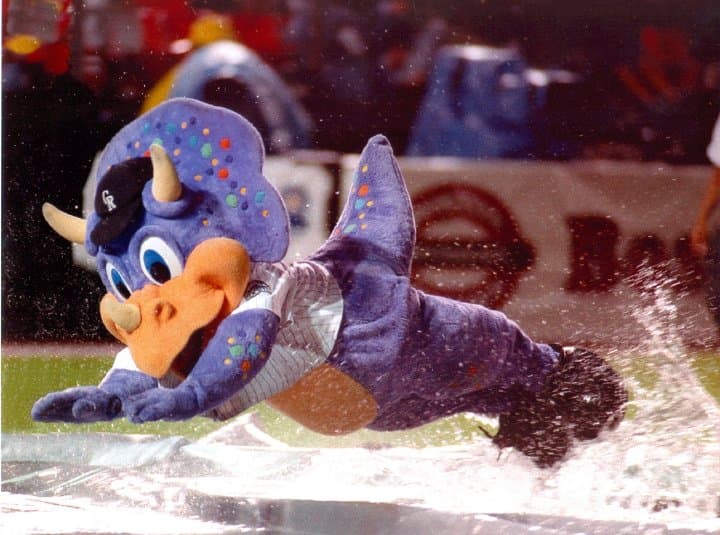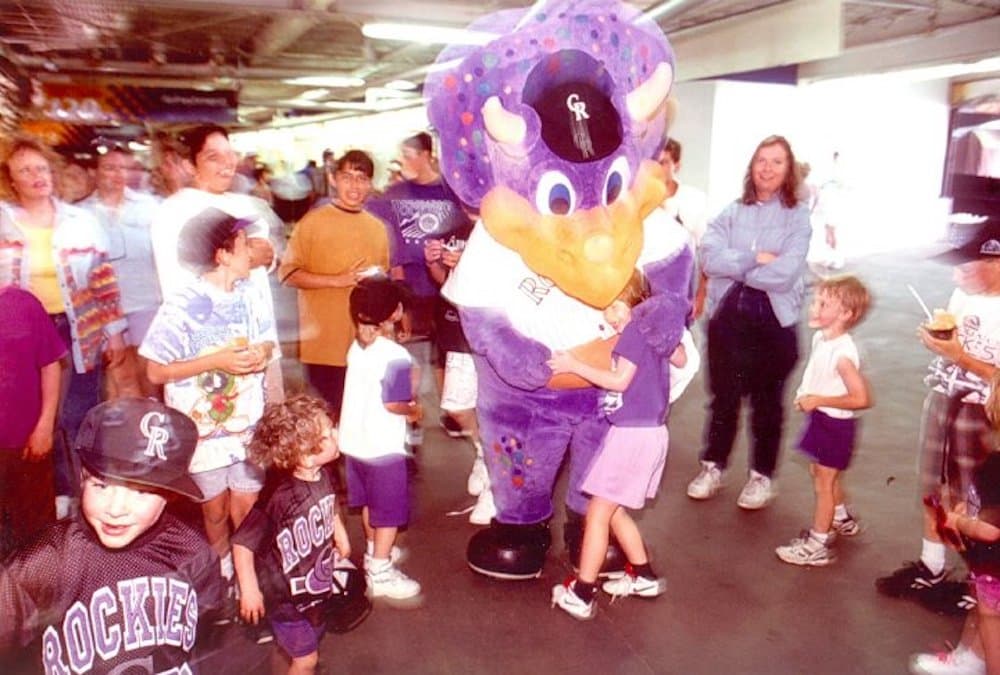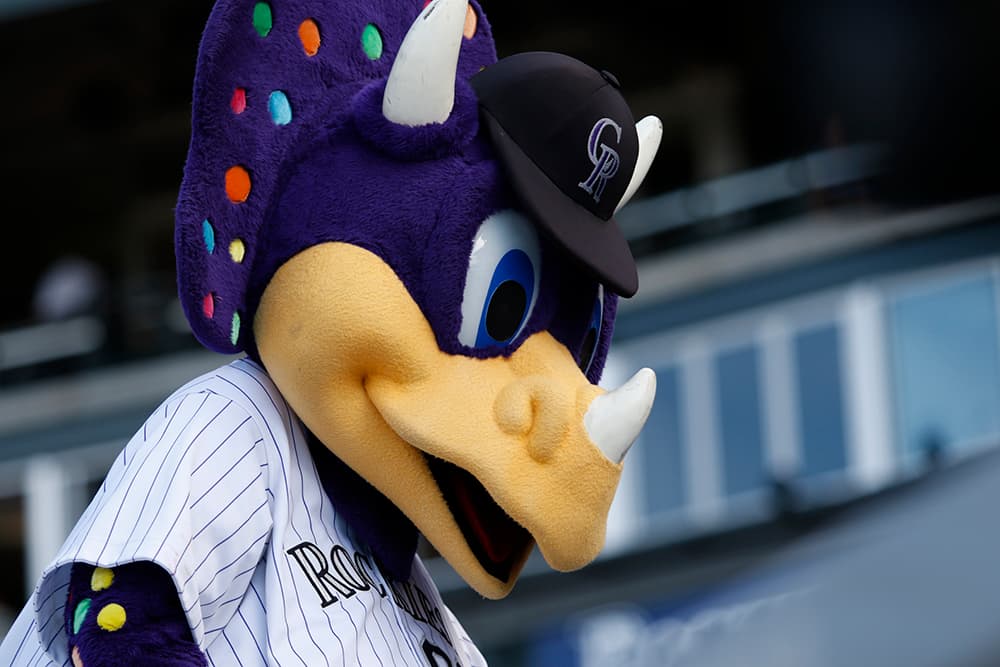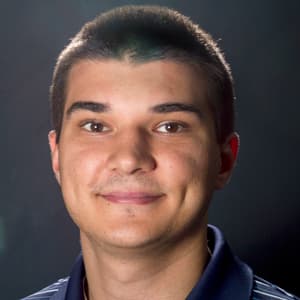
Karin Bearnarth had been working in the Colorado Rockies public relations office for about a year when a giant purple egg was discovered at Coors Field in January 1994.
The stadium was nothing more than a skeleton then — a few rows of seats and scaffolding. Bearnarth was there that day to give local media an early look at the Rockies' soon-to-be home. At least, that's what she told them.
Bearnarth began to say a few words about the stadium project. The Rockies were slated to move into Coors Field at the start of the 1995 season. At the time, Colorado still played in the old Mile High Stadium.
Midway through her presentation, a construction worker interrupted her just like the two had planned.
"He said, ‘Come over. Come quick,'" recalled Bearnarth, the daughter of then-Rockies pitching coach Larry Bearnarth. "We found something. We found something.' We all ran over."
The media huddled around a hole the construction crew had dug. They watched as the construction crew lifted out a bone they said belonged to a dinosaur. Then the crew continued to dig and dig and dig ... until they got to something purple.
"We had buried a portion of this giant purple styrofoam egg that we had made in California," Bearnarth said. "We started unearthing it. And we were like, ‘Everybody stand back. Now we have to call in the National Guard to unearth this egg.'"
The styrofoam egg was the first hint at what the team's soon-to-be mascot would be. Three months later, Dinger, a portly purple triceratops introduced to the public by a franchise still finding its way in the professional sports world, popped out and became the Colorado Rockies' official mascot, a role he still holds today.

"We didn't even really have a marketing department back then."
How could you create a purple dinosaur that didn't look like Barney?
That was one of the problems Jill Campbell tried to solve shortly after she started working for the Rockies in 1992. Campbell, who started out in the team's ticketing department, was part of the Rockies' rag tag marketing operation in the early '90s.
"We didn't even really have a marketing department back then," Campbell said. "It was mostly people on the business side who enjoyed participating the creative side of things."
There was a general consensus among that group that they wanted the team's mascot to be a dinosaur. It just seemed logical, given the history of archaeological finds in Colorado — and children's affinity for them. The Rockies' marketing team at the time also knew they wanted the mascot to be purple to match the team's primary color.
So how could Campbell help cook up a mascot that didn't make everybody immediately think of the main character on the popular children's show? To answer that question, she and Sue Ann McClarren, who's now the team's vice president of ticket sales, enlisted the help of a local paleontologist.
Together, the three of them decided that the Rockies' mascot needed to be a herbivore. Barney was a Tyrannosaurus rex — a massive carnivorous species. What was the opposite of that? Eventually, Campbell, McClarren and the paleontologist settled on a triceratops.
"Kids love triceratops for whatever reason," Campbell said. "T-rexes are scary. And pterodactyls are scary. But triceratops are out there eating leaves and grass. They’ve got to be a lot nicer."
In late 1993, the Rockies submitted their idea for a mascot to Major League Baseball. Around that time, they began discussing plans for Dinger's unveiling. They wanted to drum up interest about his identity over time — a slow burn. That's how the idea to show the media the purple egg at the first-look-at-Coors-Field ceremony was born.
The purple egg was eventually put on display at the Denver Museum of Natural History (now the Denver Museum of Nature and Science). The Rockies held another press conference in the winter of 1994, a couple weeks after the initial discovery of the egg at Coors Field.
"We had it under these bright lights," Bearnarth said. "We said, ‘We’re curious what’s going to be in the egg.' Then everybody started to catch on that this was a sort of stunt to introduce what our mascot was.
"But there was one man there — and I’m not going to tell you who he was — he was one of the reporters. He came up to me and said, ‘You know what, Karen? I think that there’s actually an X-ray machine. If you put the egg under (it), you’d actually be able to X-ray that egg and see what’s inside it.'
"I looked at him and said, 'It’s all a stunt. We’re going to have a mascot.'"

"My first question was, ‘Please tell me I’m not purple?’"
On April 16, 1994, Dinger was born. The National Guard escorted the egg in which he lay dormant into Mile High Stadium. At 12:48 p.m., the egg began to crack. One minute later, Dinger emerged from it completely naked save for a black Rockies hat. Dinger would receive a white pinstripe jersey later that day — but not a pair of pants.
Dinger greeted the crowd at Mile High with "Wild Thing" blaring in the background. After things settled down a little bit, he posed for a picture with 9-year-old Rebecca Whorton and 14-year-old Jill Nicolosi, who won the Rockies' write-in mascot naming contest by thinking up Dinger. One photo in the Rocky Mountain News depicted Dinger sticking Whorton's head in his mouth.
J.R. Moehringer, who was the Rocky Mountain News reporter on the scene that day, wrote in his article that Rockies slugger Andres Galarraga watched it all go down from the top step of the dugout with a "dip of tobacco behind his lower lip."
Joby Giacalone was the man inside the costume at the introduction ceremony. Giacalone had landed the job after a four-year stint as Homer the Dragon for the Triple-A Charlotte Knights. Giacalone didn't even know what character he was auditioning to be when he interviewed with the Rockies in 1993. All he knew was the job represented a chance to be a mascot in the big leagues.
When Giacalone found out he'd be playing a purple dinosaur, he had no issues about the type of animal the Rockies had chosen. Giacalone had just been a dragon, after all. He figured the transition would be easy. What Giacalone wasn't thrilled with was the color Colorado chose for Dinger.
"My first question was, ‘Please tell me I’m not purple?’" Giacalone recalled. "Some organizations don’t understand that animals don’t need to be the color of the team. They can be the color of the animal.
"And they said, ‘Oh yeah, of course you’re purple.’ And I’m like, ‘Really? Have you never heard of Barney?’ Their comment was, ‘Oh, but you don’t look anything like Barney.’ And I was like, ‘It doesn’t matter. If you’re a purple dinosaur, people are going to call you Barney.'"
Giacalone's instinct was correct. Moehringer described Dinger as a "creature that made children gape and Barney-loathers shriek" in his article about the mascot's birth. In 2015, Benjamin Hochman, then a columnist for the Denver Post, took it one step further and described Dinger as "Barney after a meth binge."
"I’m still frankly disappointed that it was a purple dinosaur," Giacalone said. "But it is what it is."
As Dinger, Giacalone tried to play the role of "goofy troublemaker." A character who could entertain without irking those in attendance who were serious baseball fans.
"You need to show them a respect for the game, but also how you need to be somewhat comedic," Giacalone said. "My schtick always attempts to be tongue-in-cheek, goof ball but also Dennis the Menace, gives you a hard time as well."
Giacalone wound up playing Dinger for two seasons. He retired in 1995 in order to spend more time with his two children. He now works as an IT specialist at the University of Virginia and teaches mascotting on the side to children who are interested in getting into the field.

"He’s really here for the kids."
Twenty-three years after Dinger first popped out of the egg, the Colorado Rockies' first and only mascot still waddles around relatively unchanged. He's a little darker shade of purple than he used to be. But for the most part, he still looks the same.
Over time, Campbell, Bearnarth and others who were with the Rockies when Dinger was born have heard the criticisms about the pot-bellied prehistoric creature. Campbell notes that the group of people who complain the most about Dinger aren't the ones who Dinger is supposed to entertain anyway.
"I feel like we were always explaining that to people," Campbell said. "'You know Dinger is for kids, right?' As an adult, you don’t have to be in love with Dinger. He’s really here for the kids. And that’s who we were trying to relate to from the beginning. The Rockies, we wanted to be a very family-friendly organization in terms of every aspect of our business. And the mascot was obviously a huge part of that."
Campbell is in her 25th season with the Rockies. She's worked her way up to become vice president of communications and marketing. Bearnarth ended up leaving the organization in 1996 after three seasons. She lives in Littleton with her family and works as a wedding and events planner.
Technology and the amount of money that now flows into professional sports has transformed the Rockies organization. There are 166 front office employees in the organization, according to the team's latest media guide. Everything has gone digital, too.
"We didn’t even really use internet or anything like that back then," Bearnarth said. "We had fax machines."
One of Bearnarth's fondest memories is the mascot naming contest the team conducted. Fans used landlines to phone in suggestions and sent in snail mail with prospective names. Bearnath is happy the Rockies went with Dinger — "it just fit," she said — but there was another name a grade-school kid submitted that Bearnarth found amusing, even if it was several syllables too long.
"One of my favorites was a little kid in first grade who said he wanted it to be called the Andres Galarragasaurus," Bearnarth said. "Which was a mouthful."

Subscribe to Denverite’s weekly sports newsletter here.













